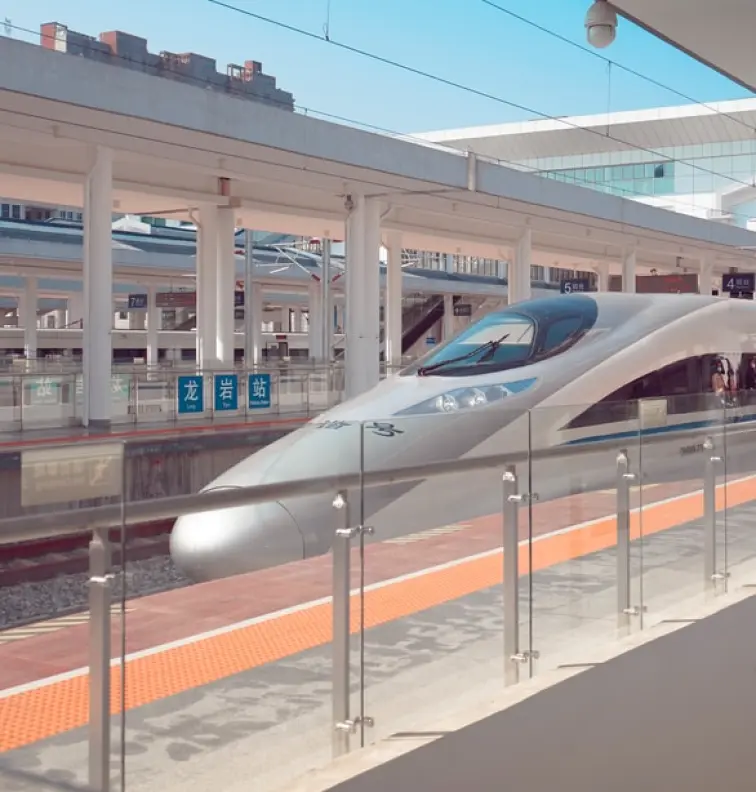The Fast Train: Experiencing the Maglev Train in Japan
Japan has long been famous for its fantastic bullet trains that make travelling the country both quick and convenient. However, there’s a new technology on the forefront of high speed rail and its name is maglev.
How do Maglev Trains Work?
So, what exactly is maglev technology and what makes it so special? When you break the word up into mag lev, it becomes clearer that the term maglev is a combination of the words magnetic and levitation. Maglev trains, therefore, are trains that float or levitate over a track by harnessing the power of magnetic repulsion.
Unlike a traditional train, a magnetic levitation train uses a special linear motor with no moving parts. Instead, it actually uses magnetic forces to both elevate the train and propel it forward. The magnetic force is created by the interaction between metal coils in the rails or guideways and the superconducting electromagnets on the train itself.
There are two main types of systems, the electromagnetic suspension (EMS) systems and electrodynamic suspension (EDS), but that’s a bit beyond the basics of how maglev trains work.
But why go to all this effort? Well, because there are some major benefits to using this technology on trains. The key benefit though is that by levitating a train over its tracks, you eliminate wheel friction completely. Without friction to worry about, a magnetic train can reach incredibly high speeds and even operate normally at over 500 km/h. In fact, the fastest trains in the world all use maglev technology, with new records constantly being made.
History of Maglev Trains
Even though the concept of a levitating train is a new phenomenon, the history of maglev is a lot older than you might expect. All the way back in 1905, German inventor Alfred Zehden came up with the basic concept for the type of motor used in maglev. By 1941 there were several patents lodged in Germany for what would later be known as a maglev train.
However, it took quite a long time for technology to catch up with these forward-thinking ideas. It wasn’t until 1984 that the first commercial maglev system was introduced, although there were plenty of prototypes before it. This revolutionary maglev shuttle connected Birmingham International Airport with the Birmingham International railway station 600 metres away.
Since then, similar maglev shuttles have been introduced in Berlin, Japan’s Aichi Prefecture and the city of Incheon in South Korea. Then there’s the Shanghai Transrapid, opened in 2004, which you can read more about below. These maglev success stories are just the beginning though, as there are many maglev systems that have been proposed or currently under construction.
Japanese Maglev Trains
Which brings us neatly to Japan’s relationship to mag lev trains. In Japan, highspeed train travel has had a huge effect on transport in the country, with bullet trains allowing you to cross great distances with ease. And yet, for Japan, maglev technology is sure to have just as profound an impact.
Right now, there is already one Japanese maglev train in operation, the Linimo line in Aichi Prefecture. This 9km train runs from Fujigaoka Station in Nagoya to Yakusa Station in the city of Toyota and has a top speed of 100km/h or 62mph. Sure, it may not be able to rival the fastest speeds of a bullet train, but it’s still an impressive system.
The Future of Japanese Maglev Trains
The future of maglev trains in Japan is tied to the SCMaglev system being used for the Chūō Shinkansen currently in development. This new high speed shinkansen is planned to connect Tokyo and Nagoya by 2027, then extend to Osaka by 2045, with construction currently underway.
Speed tests performed on this system developed by Central Japan Railway Company indicate that it will not only be the country’s fastest high speed train but indeed the world's fastest train. With its record breaking speed, it is believed it will be able to travel from Tokyo to Osaka in just one hour, less than half the current travel time.
What is the Fastest Train in the World?
The World’s Fastest Train
With so much talk about trains and insanely fast speeds, it is only natural to wonder “what is the fastest train in the world”? Well, there are two ways you could look at this, either settling on the fastest train currently operating or go with the fastest train speed ever reached.
The fastest maglev train, and in fact the only high speed mag lev train currently in commercial use, is the Shanghai Transrapid. This train connecting Shanghai Pudong International Airport with Pudong district of Shanghai has a top speed of 430 km/h or 270 mph. That means it can travel over 100km/h faster than the highest bullet train speed.
As for the fastest speeds ever reached by a train, the honour of fastest train in the world goes to the L0 Series SCMaglev in Japan. On its test track this Japanese maglev train reached a top speed of 603 km/h or 375 mph. That incredible achievement means it can travel at almost double regular shinkansen speeds.
The Fastest Train in Japan
Since Japan has no active magnetic trains so far, the crown of fastest train in Japan belongs to the country’s beloved bullet trains, known as shinkansen. Currently, the fastest bullet train in Japan is the Hayabusa train service on the Tohoku Shinkansen line, operated by JR East. This Japanese fast train reaches speeds of 320 km/h or 200 mph, which is the current bullet train top speed.
However, technology is always evolving and the Alfa-X shinkansen currently in development looks like it will easily break the record shinkansen speed. Tests in 2019 showed that it will likely be the country’s fastest passenger train when it is in operation in 2030, with an operational speed of 360 km/h or 224 mph and top speed of 400 km/h or 249 mph.
Riding Japan’s Highspeed Trains
While you may have to wait a while to hop aboard maglev trains on the Japan high speed rail network, there is no wait to travel on the current Japanese fast trains. There are nine shinkansen lines that cross the country as part of the Japan high speed rail network, making it incredibly easy to travel between destinations.
One great way of making the most of these shinkansen is by getting yourself a Japan Rail Pass. Using the JR Pass you have unlimited access to most train services on all of the lines. Even the rare few exceptions that aren’t included have suitable alternatives that are just as convenient. Using this extensive high speed rail network, you’ll have the opportunity to sit back, relax and watch the Japanese countryside rocket by your window.


